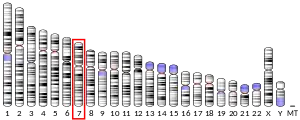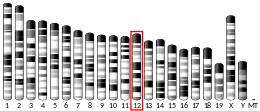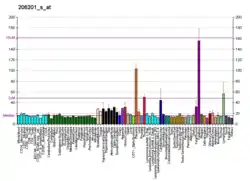MEOX2
Homeobox protein MOX-2 is a protein that in humans is encoded by the MEOX2 gene.[5][6]
Function
This gene encodes a member of a subfamily of non-clustered, diverged, antennapedia-like homeobox-containing genes. The encoded protein may play a role in the regulation of vertebrate limb myogenesis. Mutations in the related mouse protein may be associated with craniofacial and/or skeletal abnormalities, in addition to neurovascular dysfunction observed in Alzheimer's disease.[6]
References
- GRCh38: Ensembl release 89: ENSG00000106511 - Ensembl, May 2017
- GRCm38: Ensembl release 89: ENSMUSG00000036144 - Ensembl, May 2017
- "Human PubMed Reference:". National Center for Biotechnology Information, U.S. National Library of Medicine.
- "Mouse PubMed Reference:". National Center for Biotechnology Information, U.S. National Library of Medicine.
- LePage DF, Altomare DA, Testa JR, Walsh K (May 1995). "Molecular cloning and localization of the human GAX gene to 7p21". Genomics. 24 (3): 535–40. doi:10.1006/geno.1994.1663. PMID 7713505.
- "Entrez Gene: MEOX2 mesenchyme homeobox 2".
- Stamataki D, Kastrinaki M, Mankoo BS, Pachnis V, Karagogeos D (Jun 2001). "Homeodomain proteins Mox1 and Mox2 associate with Pax1 and Pax3 transcription factors". FEBS Lett. 499 (3): 274–8. doi:10.1016/S0014-5793(01)02556-X. PMID 11423130. S2CID 40668112.
Further reading
- Grigoriou M, Kastrinaki MC, Modi WS, Theodorakis K, Mankoo B, Pachnis V, Karagogeos D (1995). "Isolation of the human MOX2 homeobox gene and localization to chromosome 7p22.1-p21.3". Genomics. 26 (3): 550–5. doi:10.1016/0888-7543(95)80174-K. PMID 7607679.
- Reardon W, McManus SP, Summers D, Winter RM (1994). "Cytogenetic evidence that the Saethre-Chotzen gene maps to 7p21.2". Am. J. Med. Genet. 47 (5): 633–6. doi:10.1002/ajmg.1320470510. PMID 8266988.
- Quinn LM, Latham SE, Kalionis B (2000). "The homeobox genes MSX2 and MOX2 are candidates for regulating epithelial-mesenchymal cell interactions in the human placenta". Placenta. 21 Suppl A: S50–4. doi:10.1053/plac.1999.0514. PMID 10831122.
- Stamataki D, Kastrinaki M, Mankoo BS, Pachnis V, Karagogeos D (2001). "Homeodomain proteins Mox1 and Mox2 associate with Pax1 and Pax3 transcription factors". FEBS Lett. 499 (3): 274–8. doi:10.1016/S0014-5793(01)02556-X. PMID 11423130. S2CID 40668112.
- Gorski DH, Leal AJ (2003). "Inhibition of endothelial cell activation by the homeobox gene Gax". J. Surg. Res. 111 (1): 91–9. doi:10.1016/S0022-4804(03)00042-8. PMID 12842453.
- Wu Z, Guo H, Chow N, Sallstrom J, Bell RD, Deane R, Brooks AI, Kanagala S, Rubio A, Sagare A, Liu D, Li F, Armstrong D, Gasiewicz T, Zidovetzki R, Song X, Hofman F, Zlokovic BV (2005). "Role of the MEOX2 homeobox gene in neurovascular dysfunction in Alzheimer disease". Nat. Med. 11 (9): 959–65. doi:10.1038/nm1287. PMID 16116430. S2CID 12998034.
- Rual JF, Venkatesan K, Hao T, Hirozane-Kishikawa T, Dricot A, Li N, Berriz GF, Gibbons FD, Dreze M, Ayivi-Guedehoussou N, Klitgord N, Simon C, Boxem M, Milstein S, Rosenberg J, Goldberg DS, Zhang LV, Wong SL, Franklin G, Li S, Albala JS, Lim J, Fraughton C, Llamosas E, Cevik S, Bex C, Lamesch P, Sikorski RS, Vandenhaute J, Zoghbi HY, Smolyar A, Bosak S, Sequerra R, Doucette-Stamm L, Cusick ME, Hill DE, Roth FP, Vidal M (2005). "Towards a proteome-scale map of the human protein-protein interaction network". Nature. 437 (7062): 1173–8. Bibcode:2005Natur.437.1173R. doi:10.1038/nature04209. PMID 16189514. S2CID 4427026.
- Lin J, Friesen MT, Bocangel P, Cheung D, Rawszer K, Wigle JT (2006). "Characterization of Mesenchyme Homeobox 2 (MEOX2) transcription factor binding to RING finger protein 10". Mol. Cell. Biochem. 275 (1–2): 75–84. doi:10.1007/s11010-005-0823-3. PMID 16335786. S2CID 30515981.
- Kimura K, Wakamatsu A, Suzuki Y, Ota T, Nishikawa T, Yamashita R, Yamamoto J, Sekine M, Tsuritani K, Wakaguri H, Ishii S, Sugiyama T, Saito K, Isono Y, Irie R, Kushida N, Yoneyama T, Otsuka R, Kanda K, Yokoi T, Kondo H, Wagatsuma M, Murakawa K, Ishida S, Ishibashi T, Takahashi-Fujii A, Tanase T, Nagai K, Kikuchi H, Nakai K, Isogai T, Sugano S (2006). "Diversification of transcriptional modulation: Large-scale identification and characterization of putative alternative promoters of human genes". Genome Res. 16 (1): 55–65. doi:10.1101/gr.4039406. PMC 1356129. PMID 16344560.
- Chen Y, Leal AD, Patel S, Gorski DH (2007). "The homeobox gene Gax activates p21WAF1/CIP1 expression in vascular endothelial cells through direct interaction with upstream AT-rich sequences". J. Biol. Chem. 282 (1): 507–17. doi:10.1074/jbc.M606604200. PMC 1865102. PMID 17074759.
External links
- MEOX2+protein,+human at the US National Library of Medicine Medical Subject Headings (MeSH)
This article incorporates text from the United States National Library of Medicine, which is in the public domain.
This article is issued from Wikipedia. The text is licensed under Creative Commons - Attribution - Sharealike. Additional terms may apply for the media files.





